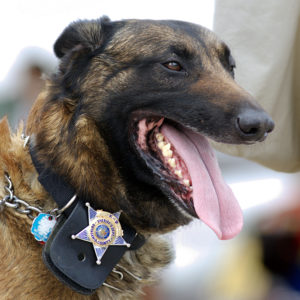The assassination attempt on former president Donald Trump, the broadly elevated terrorism threat in the United States, and now heightened concerns heading into election season underscore that security at campaign events and government facilities is more important than ever.
Even as these threats mount, federal, state and local agencies continue to experience a shortage of high-quality dogs trained to detect explosives.
For experts who track this issue, the conclusions of a troubling government report released three-plus years ago still stand as a guidepost today. The federal government “has faced a chronic shortage of domestically bred working dogs qualified for use by both the Department of Defense and other federal agencies. As adversaries, both peer and near-peer, become more adept in circumventing detection systems, the need for working dogs has steadily increased to address security vulnerabilities,” the 157-page report stated.
The government maintains 5,000 working dogs across several departments, including Defense, Homeland Security, Justice, State and Agriculture. Only 7 percent are bred domestically.
At the heart of the issue is supply and demand. Europe remains a friendlier environment for breeding and raising such specialized dogs. However, the best and most capable among them are retained for use in Europe, where the United States is competing against Russia and China for the remaining dogs.
Moreover, the overwhelming reliance on foreign markets for such an essential counter-terrorism defense highlights a dangerous vulnerability. “The lack of a robust domestic supply of working dogs creates increased supply chain risk and may threaten the ability of departments and agencies that utilize working dogs to maintain readiness if the supply from foreign markets is contested or interrupted for an extended period,” the report concluded.
Security experts have been ringing the alarm bell for years. It’s why the American Kennel Club recently held a gathering of dog breeders, security professionals from federal agencies, researchers, trainers, breeders and policymakers to address the deficit. The AKC National Detection Dog Conference was the fifth such gathering in 12 years, where attendees examined cooperative solutions to the shortage of U.S.-bred detection canines.
A range of fixes has been taking shape since the first gathering. One is a specialized program that assists U.S. breeders of Labrador Retrievers and German Shorthaired Pointers interested in learning how to raise a puppy suitable for advanced training as a detection dog. The program will soon graduate its 100th dog, providing breeders with hands-on training and mentoring with industry experts. It has placed graduates with the U.S. Capitol and federal agencies in the last year.
Another fix is information sharing among experts and breeders of leading-edge scientific research about what is necessary to develop a world-class detection dog program and sharing developments in their health and training for these essential detection missions.
A third fix is in the hands of the government. Boosting the supply of domestic dogs requires a major push to make its byzantine federal buying system more user-friendly to dog breeders, who are typically hobbyists or micro businesses with little or no federal contracting experience.
Encouraging breeders to participate is essential because these dogs are different from family pets or rescue dogs. Working dogs require strength and stamina to work in inhospitable conditions and intense mental concentration to discern a specific odor among thousands of others. They need a combination of highly capable breeding and expert training to develop into partners in the defense against terrorism.
FBI Director Christopher Wray earlier this year warned that threats from homegrown extremists, jihadists, foreign terrorist organizations and state-sponsored terrorist organizations were already high but have “gone to a whole other level” since the Hamas terror attacks against Israel last October. “And so, this is a time, I think, for much greater vigilance.”
Greater vigilance is only possible with domestically bred working dogs that are the best in the world.





